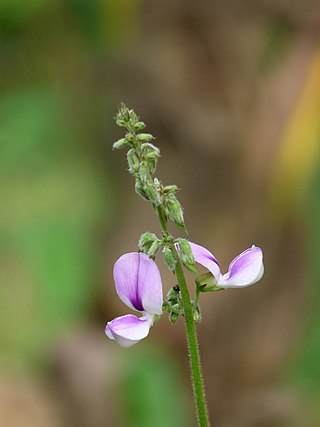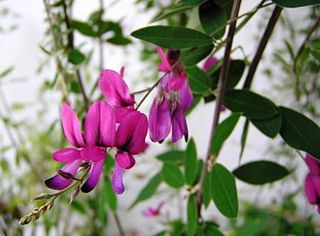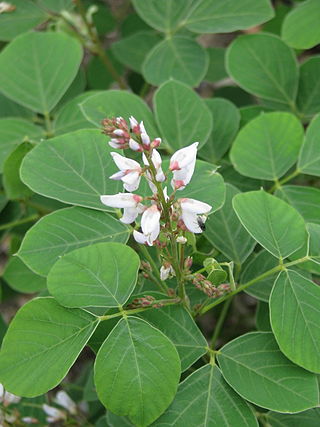
Dalbergia is a large genus of small to medium-size trees, shrubs and lianas in the pea family, Fabaceae, subfamily Faboideae. It was recently assigned to the informal monophyletic Dalbergia clade : the Dalbergieae. The genus has a wide distribution, native to the tropical regions of Central and South America, Africa, Madagascar and southern Asia.

Aralia, or spikenard, is a genus of the family Araliaceae, consisting of 68 accepted species of deciduous or evergreen trees, shrubs, and rhizomatous herbaceous perennials. The genus is native to Asia and the Americas, with most species occurring in mountain woodlands. Aralia plants vary in size, with some herbaceous species only reaching 50 centimetres (20 in) tall, while some are trees growing to 20 metres (66 ft) tall.

Pueraria is a genus of 15–20 species of legumes native to south, east, and southeast Asia and to New Guinea and northern Australia. The best known member is kudzu, also called Japanese arrowroot. The genus is named after 19th century Swiss botanist Marc Nicolas Puerari.

Lespedeza is a genus of some 45 species of flowering plants in the pea family (Fabaceae), commonly known as bush clovers or Japanese clovers (hagi). The genus is native to warm temperate to subtropical regions of eastern North America, eastern and southern Asia and Australasia.

Sir David Prain was a Scottish botanist who worked in India at the Calcutta Botanical Garden and went on to become Director of the Royal Botanic Gardens, Kew.

Linnaea is a plant genus in the honeysuckle family Caprifoliaceae. Until 2013, the genus included a single species, Linnaea borealis. In 2013, on the basis of molecular phylogenetic evidence, the genus was expanded to include species formerly placed in Abelia, Diabelia, Dipelta, Kolkwitzia and Vesalea. However, this is rejected by the majority of subsequent scientific literature and flora.

Blumea is a genus of flowering plants of the family Asteraceae.

Campylotropis is a genus of flowering plants in the legume family, Fabaceae. It includes 41 species of shrubs native to Asia, ranging from the Himalayas to Indochina, China, Taiwan, Mongolia, and Korea, as well as Java and the Lesser Sunda Islands. Typical habitats include seasonally-dry tropical montane forests to temperate forest, woodland, and bushland. The genus belongs to subfamily Faboideae.

Dunbaria is a genus of flowering plants in the legume family, Fabaceae. It belongs to the subfamily Faboideae. It includes 19 species which range from India to Indochina, China, Korea, Japan, Malesia, New Guinea, and northern Australia.

Uraria is a genus of plants in the legume family, Fabaceae. It includes 24 species of shrubs and subshrubs native to sub-Saharan Africa, the Indian Subcontinent, Indochina, China, Malesia, Papuasia, Australia, and the South Pacific. Typical habitats are seasonally-dry tropical woodland or grassland. It belongs to the subfamily Faboideae and the tribe Desmodieae.

The tribe Desmodieae is one of the subdivisions of the plant family Fabaceae. It is composed of two subtribes, Desmodiinae and Lespedezinae. Recent phylogenetics has this tribe nested within tribe Phaseoleae.

Adina is a genus of 12 species of flowering plants in the family Rubiaceae. They are shrubs or small trees, native to East Asia and Southeast Asia.

Phanera is a genus of flowering plants in the legume subfamily Cercidoideae and the tribe Bauhinieae. This genus differs from Bauhinia in being vines or lianas, generally with tendrils and a lobed rather than spathaceous calyx, and from Schnella in having only three fertile stamens rather than ten, and being native to the Indomalayan realm and the Australasian realm rather than the Americas. The subsection Corymbosae was recently segregated into a new genus, Cheniella. It has been suggested that the genus Lasiobema should be reduced to a section within Phanera.

Ototropis elegans is a shrub in the pea family (Fabaceae) native to Asia from Afghanistan to north-central China. Infraspecific taxa include:

Grona is a genus in the flowering plant family Fabaceae. Its native range is worldwide tropics and subtropics.
Melanoseris is a genus of flowering plants belonging to the family Asteraceae.
Sohmaea is a genus of flowering plants belonging to the family Fabaceae.

Sunhangia is a genus of flowering plants in the pea family (Fabaceae). It includes six species, which range from Afghanistan through Pakistan, India, Tibet, Myanmar, and south-central and north-central China. The species in the genus were formerly placed in genus Desmodium.
Daprainia kingiana is a species of flowering plant in the legume family, Fabaceae. It is a shrub native to Myanmar, Laos, Thailand, and Cambodia. It is the sole species in genus Daprainia.
















